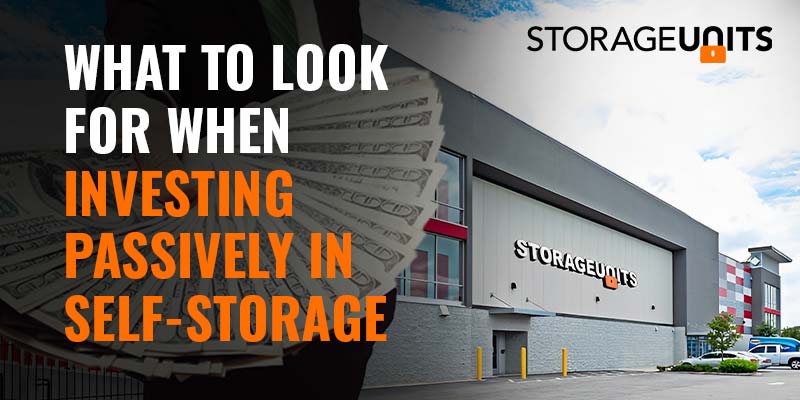What to Look for When Investing Passively in Self-Storage

Self-storage facilities are a popular and rapidly growing investment opportunity for passive investors. With the increase in demand for storage space, the self-storage industry is predicted to continue growing steadily. As a passive investor, investing in self-storage can provide a steady income stream without requiring active involvement in day-to-day operations.
Overview of self-storage investing
Self-storage investing refers to investing in self-storage facilities, which are commercial properties that provide storage space for individuals and businesses. Self-storage facilities typically have a variety of unit sizes and offer month-to-month leases.
Self-storage investing can be an attractive option for investors looking for a stable source of passive income. This is because self-storage facilities tend to have low operating costs and high occupancy rates, which can translate into relatively steady cash flow for investors. Also, self-storage facilities are usually less vulnerable to economic downturns than other commercial properties, as people and businesses tend to need storage space even in tough economic times.
However, self-storage investing also has its challenges. Competition can be stiff, especially in highly populated areas, and finding the right location for a self-storage facility can be crucial to its success. Investors will also need to consider the costs of maintenance and upgrades to keep the facility competitive and up to code.
Before investing in self-storage, there are several key factors to consider.
1. Market demand and location
Conduct market research to determine the level of demand for self-storage in the area, such as by surveying potential customers and analyzing online search trends.
The facility’s location is one of the most important factors to consider when investing in self-storage. The location of the facility can have a significant impact on the success of the investment. For example, a self-storage facility in a densely populated area with limited storage options is more likely to attract customers and generate higher returns. Additionally, self-storage facilities near significant highways, commercial centers, or residential neighborhoods can be more convenient for potential customers and provide better accessibility.
2. Occupancy Rates
The occupancy rates of a self-storage facility are another essential factor to consider when investing. High occupancy rates indicate a healthy investment, indicating that the facility is in high demand and generating a steady income. On the other hand, low occupancy rates can be a red flag, indicating that the facility may not meet the market’s needs. Therefore, before investing in a self-storage facility, it is essential to review its occupancy rates over time to assess its potential for generating consistent income.
3. Security Measures
Security is another vital factor to consider when investing in self-storage. Customers rely on the facility to keep their belongings safe and secure, so it is essential to ensure that the facility has adequate security measures. This can include security cameras, gated access, and on-site management. Investing in a facility with strong security measures can reduce the risk of theft or damage to the storage units and increase customer satisfaction.
4. Maintenance and Upkeep
Self-storage facilities require ongoing maintenance and upkeep to ensure they are safe, clean, and functional. Reviewing the facility’s maintenance and upkeep practices is essential when considering an investment in a self-storage facility. A well-maintained facility is more likely to attract and retain customers, generating steady income over time.
5. Management
The management of a self-storage facility can have a significant impact on the success of the investment. A strong management team can help attract and retain customers, maintain high occupancy rates, and ensure the facility is well-maintained. Therefore, before investing in a self-storage facility, it is essential to review the management team’s experience and track record in the industry.
6. Population and demographic trends
Look at the population growth and demographics of the area to determine if there is a need for self-storage. For example, if the site has a growing population of young professionals, there may be a higher demand for temporary storage as people move frequently.
7. Economic indicators
Assess the local economic conditions, including employment rates, household income, and real estate trends. A strong economy and rising property values can indicate an increased demand for storage.
8. Local zoning laws and regulations:
Check for any restrictions on the construction or operation of self-storage facilities in the area. Some municipalities may have specific zoning laws that limit the location or size of self-storage facilities.
9. Accessibility and visibility
Evaluate the location of the potential self-storage facility regarding accessibility, visibility, and proximity to major roads and highways. A place that is easy to access and visible from major routes can increase the chances of attracting customers.
How to Invest Passively in Self-Storage Facilities?
Invest in a professionally managed, vertically integrated self-storage fund focused on high-growth self-storage facilities in the fastest-growing markets of the Southeast.
Step 1: Download this free passive self-storage investment guide.
Step 2: Schedule a one-on-one strategy session to discuss your investment goals.
Conclusion
Investing in self-storage can be a lucrative opportunity for passive investors. However, before investing, it is essential to carefully consider the facility’s location, occupancy rates, security measures, maintenance and upkeep practices, and the management team’s experience. By considering these factors, investors can make informed decisions and maximize their returns.
